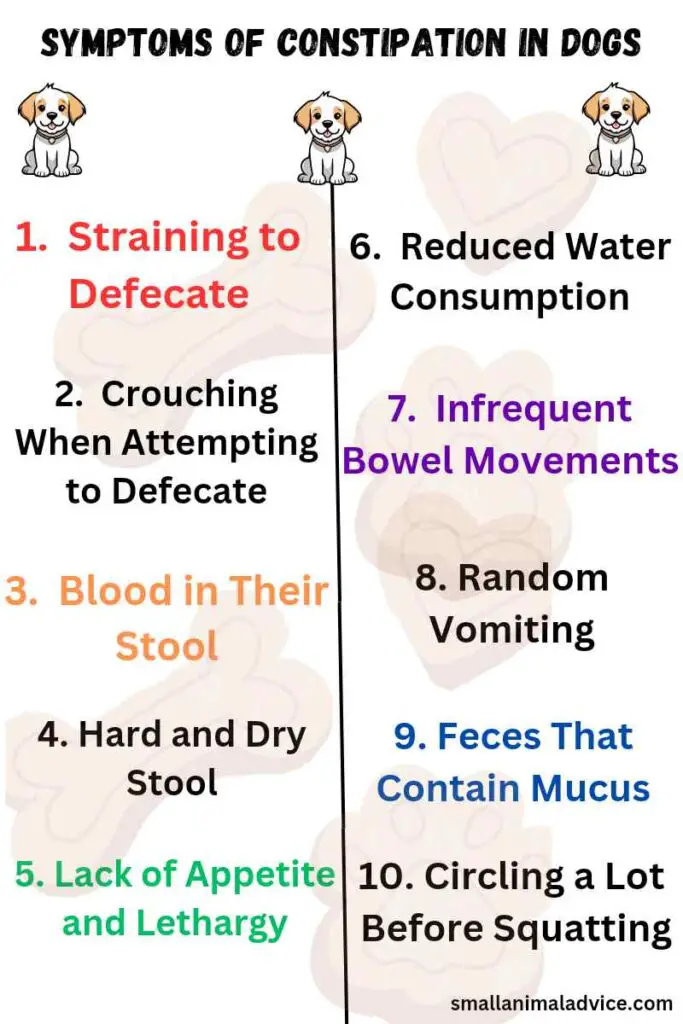10 Most Common Symptoms of Constipation in Dogs

Today, let’s talk about a common but often overlooked issue: symptoms of constipation in dogs.
Just like us humans, our furry friends can experience discomfort and digestive troubles too.
In this article, we’ll explore the telltale signs of constipation in dogs and what you can do to help them get back to wagging their tails with ease.
Symptoms of Constipation in Dogs
Constipation in dogs can be identified by symptoms such as straining, crying, or crouching when attempting to defecate, lack of defecation for a few days, hard and pebble-like stool, painful defecation, and mucus with stool.
Other clinical signs include decreased appetite, vomiting, small amounts of watery feces or feces that contain mucus, scooting, or squatting frequently, or even crying out in severe cases.
Some constipated dogs will have a tense, painful abdomen and cry or growl if you press on their stomach or lower back.
If you observe any of these symptoms, it is important to contact your veterinarian for an exam and treatment.

Let’s break it down further…
Here are some of the most common symptoms of constipation in dogs:
1. Straining to Defecate
One common symptom of constipation in dogs is straining to defecate.
You may notice your dog making repeated attempts to poop without much success.
They might assume a position to defecate but struggle to produce a bowel movement.
They may strain, squat, or make pushing motions without actually eliminating anything. This can be a sign that their stool is hard and difficult to pass.
2. Crying or Crouching When Attempting to Defecate
If your dog is constipated, they may exhibit signs of discomfort or pain when trying to defecate.
You might observe them crying, whimpering, or even yelping during the process.
They may also exhibit unusual body postures such as crouching low to the ground or assuming a hunched position.
These behaviors can indicate that they’re experiencing discomfort while trying to pass stool.
3. Blood in Their Stool
Another symptom that can occur in cases of constipation is the presence of blood in the dog’s stool.
When the stool is hard and dry, it can cause irritation and damage to the rectal area, leading to small tears or fissures.
These tears can result in the appearance of fresh blood in the stool.
If you notice blood in your dog’s stool, it’s important to consult with a veterinarian to determine the underlying cause and appropriate treatment.
4. Hard and Dry Stool
When it comes to identifying constipation in dogs, one of the most noticeable signs is the appearance of hard and dry stool.
Normally, a dog’s stool should have a moist and firm consistency.
However, if your furry friend is constipated, the stool may become dry, compacted, and difficult to pass.
It might even resemble small, hard pellets. Keep an eye out for any changes in your dog’s bowel movements.
5. Lack of Appetite and Lethargy
Another common symptom of constipation in dogs is a lack of appetite and lethargy.
If your dog is experiencing discomfort or pain due to constipation, they may lose interest in their food.
This reduced appetite can be accompanied by general lethargy or a decrease in energy levels.
If you notice a sudden change in your dog’s eating habits or overall activity level, it’s worth considering constipation as a possible cause.
6. Reduced Water Consumption
Dehydration can contribute to constipation in dogs, so a reduction in water consumption is another symptom to watch out for.
When a dog is constipated, they may instinctively try to avoid drinking water because they associate it with discomfort during bowel movements.
However, this can exacerbate the problem, as proper hydration is crucial for maintaining healthy digestion.
If you notice your dog drinking less water than usual, it’s important to address the issue promptly.
7. Circling a Lot Before Squatting
Have you noticed your dog circling excessively before attempting to squat for a bowel movement?
This behavior can be indicative of constipation in dogs.
Dogs may circle because they are trying to find a more comfortable position or are experiencing discomfort while trying to pass stool.
If you observe your dog repeatedly circling before finally defecating, it could be a sign that they are constipated.
8. Watery Feces or Feces That Contain Mucus
When a dog is constipated, you might notice a change in the consistency of their feces.
In some cases, their stools may become watery or contain mucus.
This can happen because the stool is becoming backed up in the colon, causing the liquid portion to pass around the harder, impacted stool.
If you see this change in your dog’s bowel movements, it could be a sign of constipation.
9. Random Vomiting
Another symptom that can be associated with constipation in dogs is random vomiting.
When the digestive system is blocked or slowed down due to constipation, it can cause the stomach to become irritated.
This irritation can lead to vomiting. However, it’s important to note that vomiting can also be a sign of other health issues, so it’s always a good idea to consult with a veterinarian to determine the exact cause.
10. Infrequent Bowel Movements
One of the most obvious signs of constipation in dogs is infrequent bowel movements or difficulty passing stools.
If you notice that your dog is straining, spending a long time in the squatting position without producing anything, or having fewer bowel movements than usual, it could be an indication of constipation.
Keep in mind that the normal frequency of bowel movements can vary depending on the dog’s age, diet, and activity level.
However, if you notice a significant change from your dog’s usual pattern, it’s worth investigating further.
FAQs
What are the common symptoms of constipation in dogs?
Dogs might show signs of constipation by straining or having difficulty when trying to defecate, producing hard or small stools, or even not being able to pass stools at all. They may also exhibit discomfort, restlessness, and even loss of appetite.
How can I tell if my dog is constipated?
Keep an eye out for signs such as infrequent bowel movements, visible discomfort during defecation, abdominal bloating, or even vomiting. If you notice any of these symptoms, it’s best to consult with a veterinarian for a proper diagnosis.
What causes constipation in dogs?
Constipation in dogs can be caused by a variety of factors such as dehydration, lack of fiber in their diet, ingesting foreign objects, underlying medical conditions, or even side effects of certain medications.
Read more about what causes constipation in dogs.
Can I help relieve my dog’s constipation at home?
You can try increasing your dog’s water intake, adding more fiber to their diet through options like canned pumpkin or specific high-fiber dog foods, and ensuring they get regular exercise to help promote bowel movements. However, if the constipation persists, it’s crucial to seek veterinary advice.
Read more about dealing with constipation in dogs.
When should I be concerned about my dog’s constipation?
If your dog shows signs of severe distress, persistent constipation lasting more than 2-3 days, or if there’s blood in their stool, it’s important to seek immediate veterinary attention as these could indicate a more serious underlying issue.
Are certain dog breeds more prone to constipation?
While constipation can affect any dog, certain breeds such as Bulldogs, Pugs, and other brachycephalic breeds may be more susceptible due to their unique anatomy and potential respiratory issues which can impact their overall digestive health.
Read more about preventing constipation in dogs.
Conclusion
In conclusion, keeping an eye out for the symptoms of constipation in dogs is crucial for their well-being. Remember, if you notice infrequent or difficult bowel movements, discomfort, or loss of appetite, it’s time to take action. By promptly addressing constipation, we can ensure our furry friends stay happy and healthy.
